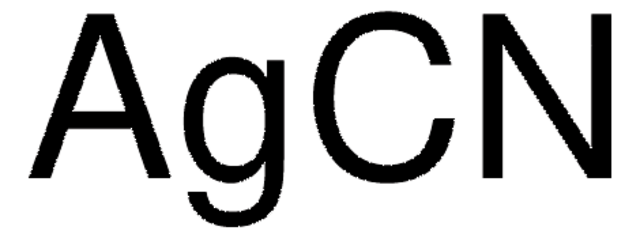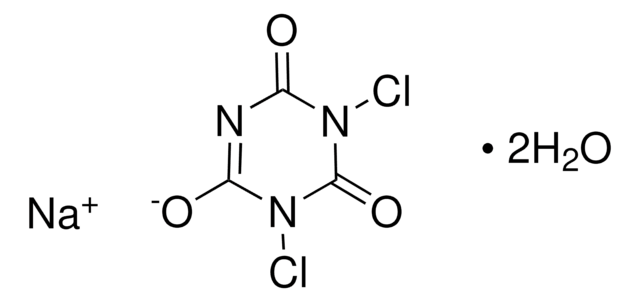379867
Kaliumdicyanaurat(I)
99.95% trace metals basis
Synonym(e):
Kaliumgoldcyanid
About This Item
Empfohlene Produkte
Assay
99.95% trace metals basis
Form
crystalline
Verunreinigungen
≤550.0 ppm Trace Metal Analysis
Dichte
3.45 g/mL at 25 °C (lit.)
SMILES String
[K+].N#C[Au-]C#N
InChI
1S/2CN.Au.K/c2*1-2;;/q;;-1;+1
InChIKey
OQHPFUBKFKRHKZ-UHFFFAOYSA-N
Suchen Sie nach ähnlichen Produkten? Aufrufen Leitfaden zum Produktvergleich
Allgemeine Beschreibung
Anwendung
- To prepare gold nanowire array electrodes with fast charge transfer ability.
- As a supporting electrolyte for the electrodeposition of gold in organic media.
- To prepare polypyrrole-ClO4 gas sensors with fast response time and high sensitivity to volatile organic compounds.
- In the electrochemical preparation of gold nanoparticle composites.
Signalwort
Danger
H-Sätze
Gefahreneinstufungen
Acute Tox. 1 Dermal - Acute Tox. 2 Inhalation - Acute Tox. 2 Oral - Aquatic Acute 1 - Aquatic Chronic 1
Zusätzliche Gefahrenhinweise
Lagerklassenschlüssel
6.1B - Non-combustible acute toxic Cat. 1 and 2 / very toxic hazardous materials
WGK
WGK 3
Flammpunkt (°F)
Not applicable
Flammpunkt (°C)
Not applicable
Persönliche Schutzausrüstung
Eyeshields, Faceshields, Gloves, type P3 (EN 143) respirator cartridges
Hier finden Sie alle aktuellen Versionen:
Besitzen Sie dieses Produkt bereits?
In der Dokumentenbibliothek finden Sie die Dokumentation zu den Produkten, die Sie kürzlich erworben haben.
Unser Team von Wissenschaftlern verfügt über Erfahrung in allen Forschungsbereichen einschließlich Life Science, Materialwissenschaften, chemischer Synthese, Chromatographie, Analytik und vielen mehr..
Setzen Sie sich mit dem technischen Dienst in Verbindung.




![Cyanid-Standardlösung traceable to SRM from NIST K₂[Zn(CN)₄] in H₂O 1000 mg/l CN Certipur®](/deepweb/assets/sigmaaldrich/product/images/920/032/af45eec3-100b-4996-8eb3-c3942d441bc9/640/af45eec3-100b-4996-8eb3-c3942d441bc9.jpg)





